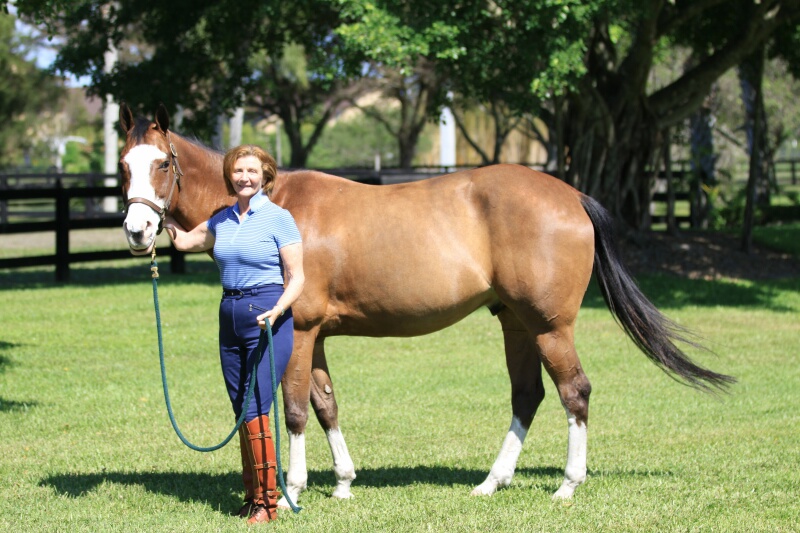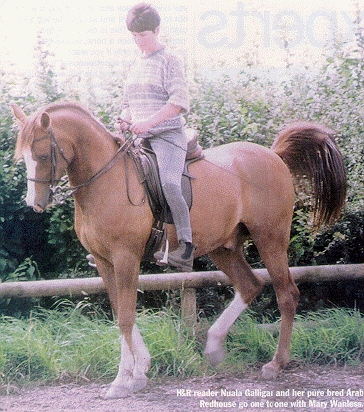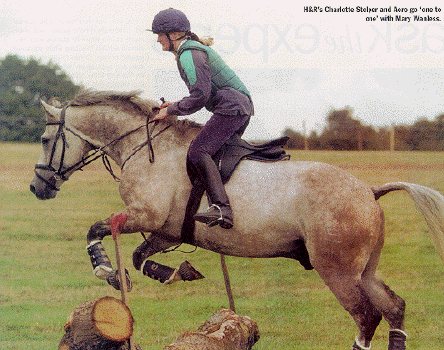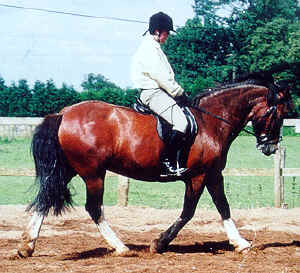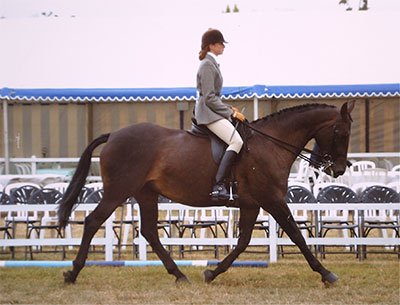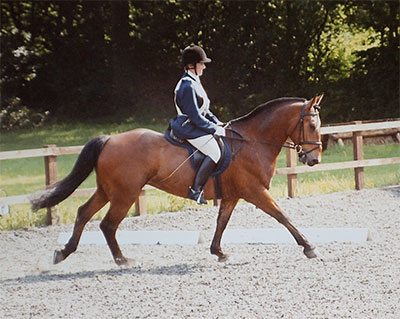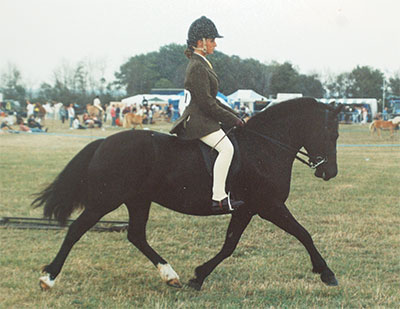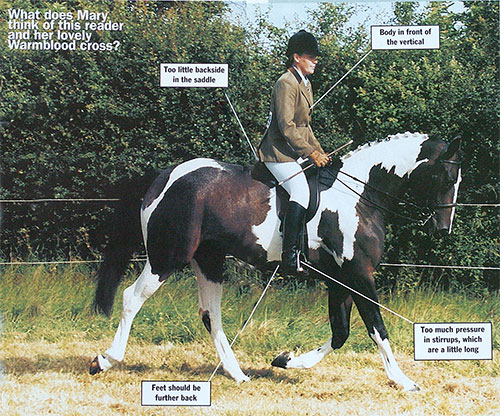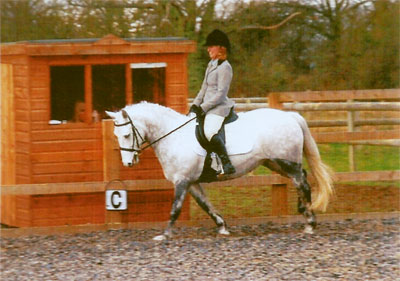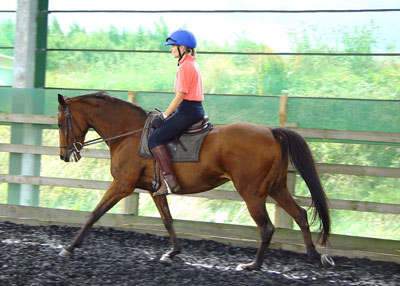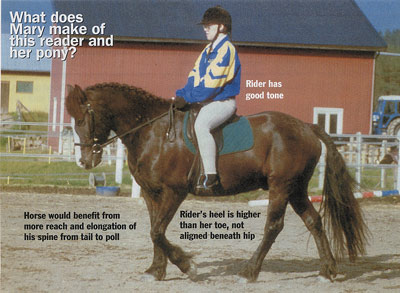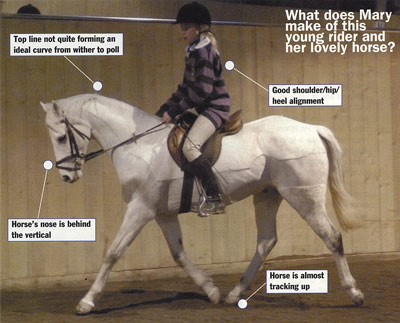RWYM
ARTICLE 34
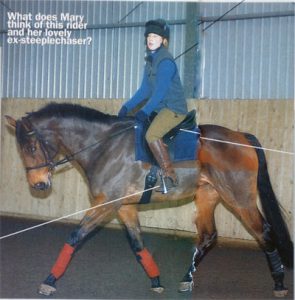 This horse is an eleven-year-old thoroughbred mare, who was a chaser until she was nine. Her owner used to ride out for the horse’s trainer, and bought the horse at the end of her racing career. Two years on the mare is much saner than she was, although her owner tells me that her tendency to be sharp, spooky and stupid has resulted in a fair few ‘dodgy moments’. Getting her attention, apparently, is one of the hardest facets of riding her, and some beatings in her racing days have left her so nervous that the rider cannot carry a stick. Our rider had hoped to event the horse, but she did not settle to a new jumping style, and has become much more happy and relaxed as a dressage horse. They have done a few affiliated Preliminary Dressage competitions.
This horse is an eleven-year-old thoroughbred mare, who was a chaser until she was nine. Her owner used to ride out for the horse’s trainer, and bought the horse at the end of her racing career. Two years on the mare is much saner than she was, although her owner tells me that her tendency to be sharp, spooky and stupid has resulted in a fair few ‘dodgy moments’. Getting her attention, apparently, is one of the hardest facets of riding her, and some beatings in her racing days have left her so nervous that the rider cannot carry a stick. Our rider had hoped to event the horse, but she did not settle to a new jumping style, and has become much more happy and relaxed as a dressage horse. They have done a few affiliated Preliminary Dressage competitions.
To begin with, the horse was very hollow and backward thinking, and her rider feels hugely relieved that she can now get her to go forward and reach into the rein. But having overcome this first hurdle, the latest problem seems to be that she would now like to overbend. Her rider wants to know how she can progress from here.
Firstly, I think she deserves our congratulations for surviving the transition from racehorse to dressage horse. Even with very good riding skills this is not easy, and two years is probably about the time it takes to wipe the slate clean, establish a new outlook on life, and develop some new movement patterns and a new musculature.
This is a nicely made horse, moving quite well. Although the rider tells us that it is hard to get her horse’s attention, here at least she has succeeded well. Notice that the horse’s ears are sideways rather than pricked, as they would be if she were admiring the view. She is close to tracking up (where the hind hoof steps into the footprint left by the front hoof). She is, as her rider says, slightly overbent, and as well as this I suspect that she may have tilted her muzzle slightly, as if to poke her nose towards us out of the photograph. The way that she is looking to the inside is not actually a correct bend, and the contact on the inside rein is also not quite correct. This is too subtle an evasion to deal with in this article.
The rider’s stirrups are very short. However, given that her history includes riding racehorses, it is not surprising that this is how she likes to ride. (I suspect that she would actually like to be shorter, and that she already feels as if she has made enough of a concession towards dressage!) It is amazing how altering your stirrups by one hole can made you feel either like a jockey, or as if you are floundering around with no stable base of support. And yet the change in length is half of the distance between each hole, and probably no more than half an inch. How delicate our balance is on a moving horse! How sensitive we are to change – and how reluctant most of us are to deal with the initial horrors of feeling different.
The ideal angle for the thighbone is about 45 degrees to the ground, and our rider’s thigh is more horizontal than this. The angle of her hip and knee joints, however, match each other quite well. Although she is somewhat on tiptoe, her foot is in about the right place. I suspect that she would just about land – and remain – on her feet if we took her horse out from under her by magic.
The rider in a good flatwork balance, and the rider folded down over a fence in jumping position, should both be in balance over their feet. So should the rider positioned anywhere on the continuum inbetween these extremes. To understand this, stand in an ‘on horse’ position with a shoulder/hip/heel vertical line. This places your shoulder seam over the boney knoble at the top outside of your thigh, which is over the boney knobble of your ankle. Ideally test this by standing sideways on to a large mirror – you may need to make adjustments to stop yourself leaning forward or back, and/or rounding or hollowing your back.
Gradually fold down into jumping position, pausing frequently along the way. As your backside goes backwards and your shoulders come forwards you ‘fold down like an ironing board’ (a wonderful description from jumping trainer Pat Burgess). Our rider here is essentially in balance whilst being part way into that fold, and the angles of her hip and knee would be absolutely appropriate for working on the flat between fences. If she were indeed doing this, we would conclude that her biggest problems lay at each end of her body. Her ‘iffy’ heel would let her down over a fence, and she is rather scrunched at the back of the neck, with her chin up, as if she herself is ‘above the bit’. Fortunately for her, this tightness has not translated through to her horse.
The angle of the thighbone is critical to the rider’s effectiveness, for the thigh acts like a lever and helps her to support her body weight. Stand again in that ‘on horse’ flatwork position, and stay there for a while. With no horse to hold you up, the quadriceps muscle at the front of your thigh works hard, just as it should when you are riding. If instead you treat the horse like an armchair and rely on him to hold you up, this thigh muscle relaxes, the horse supports your weight, and you become a much greater burden to him.
This is the biggest danger of having the thigh more horizontal than the ideal of 45 degrees to the ground. With the backside more down and the knee more up, the rider is more likely to put all her weight on her backside and to squash the horse. To her credit, our rider is not doing this, and her light frame makes her less vulnerable to this mistake. The more the rider’s weight is spread down her whole thigh the more leverage she creates as the weight acting at her knee counterbalances the weight of her upper body. The pain you feel when standing in an ‘on horse’ position is testament to the muscle work involved.
. This effort does more than simply stopping you from squashing the horse – it can actually enable you to act like a suction device, drawing his back up under you. The dressage horse who looks beautiful has lifted through his back and shortened his belly muscles, just as you would in a slight abdominal curl. The top of his neck then elongates and the underside of the neck softens. When the rider uses her thigh muscles to draw the horse’s back up it is as if she actually hangs the saddle and the horse (as well as her lower leg) off those muscles. This is not for the faint-hearted!
Many riders imagine that they should be striving for a vertical thigh, but with the thigh more vertical than 45 degrees, leverage is again lost. Without the knee in front of the hip, all of the rider’s weight is taken in the centre of the horse’s back, just where he tends to hollow. Top dressage riders show this 45 degree thigh, and so should the rest of us. Use a mirror or a friend to check this for you next time you ride. However terrible you feel when you first alter your stirrups, realise that you will adapt to the change in a surprisingly short time.
The horse’s neck is another lever. Think of his head as a weight on the end of a long pole, and to fully appreciate the point, hold a reasonably heavy object in your hand with your arm straight and horizontally out in front of you. Before long the muscles along the top of your upper arm will start to ache. These equate to the muscles at the base of the horse’s crest. When the horse starts to overbend, to drop his head down towards the ground, or to become heavy in your hand, these muscles are tiring. The long back muscles under the panels of the saddle also play a role in that counterbalance and they too are tiring. The horse that is above the bit holds his neck up from the muscles underneath it, and although this does him no good, it seems to fatigue him less, perhaps because he is then running on adrenaline. We all know horses that can keep going like this for hours!
Again it is the rider’s thighs which can help the muscles along the top of the crest to do their job. Sit on a chair, and put the fingertips of one hand in the angle between your leg and your body. Then lift your knee, and you should feel two tendons that stick up rather like taught pieces of rope. Do this several times, and then put your other hand on your knee and hold it down as you attempt to lift it. Your knee does not move, but your tendons stick up. This, together with that 45 degree angle, creates the muscle use that most helps the horse to use his back and neck muscles well. Without moving your knee, activate your tendons like his when you ride.
Remember, though, that both you and he will tire. When your thighs and his neck and back give out, expect him to overbend and/or to become heavy in your hand. Be a just and fair task-taster for both of you, and appreciate that his generousity is the greatest gift that he can give you. It is not one to be abused.

